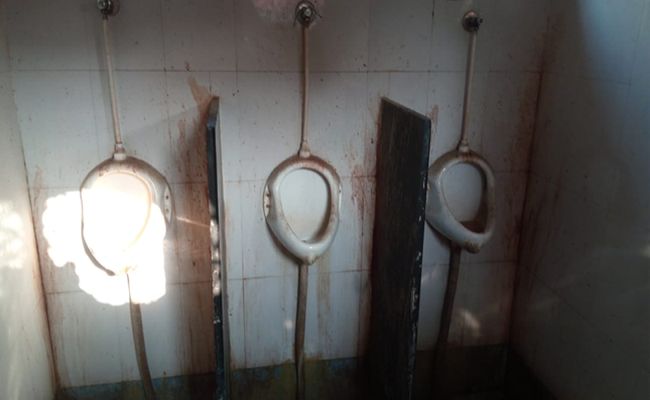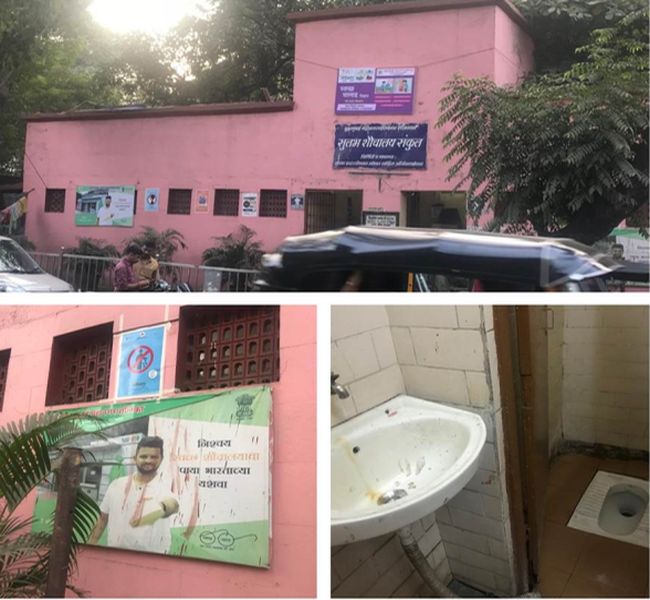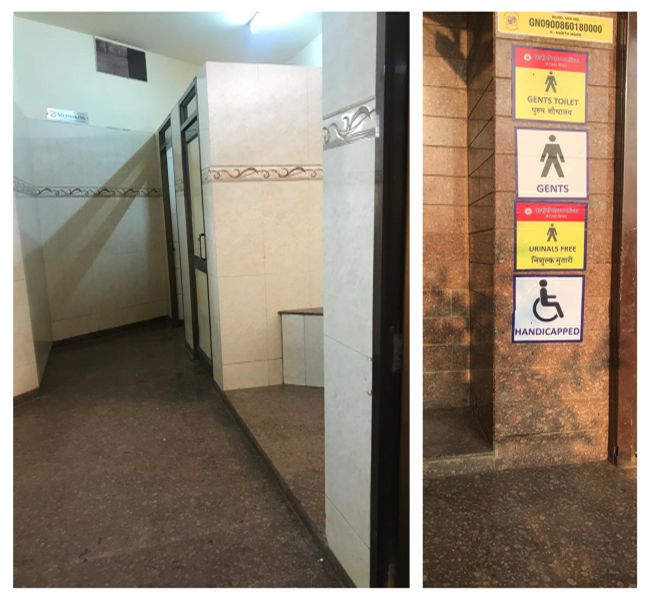Mumbai: For 16-year-old Juhi (name changed), a resident of Kandivali’s Gaondevi slum, using a toilet is no less than a battle every day. She not only has to protect herself from eve-teasers on her way to the toilet but also has to endure the repulsive stench emanating from the toilet. To add to that, she has to be constantly vigilant about who might enter accidently as the toilet has a dupatta or a long scarf hanging for privacy in place of a door. It has been a little over a month since she migrated to Mumbai from a small village in Rajasthan with her family and is already hating her stint in the city of dreams. Unfortunately, the city that boasts of an Open Defecation Free (ODF) status July 2017, is making it a struggle for Juhi to use a toilet.
The vertical toilet (a toilet that is built in a multi-storey complex) that Juhi uses is located in R-South Ward and is maintained by the Brihanmumbai Municipal Corporation (BMC). Though it is cleaned once a day, due to poor ventilation, the toilet generally stinks and there is no option but to hold your breath in its vicinity.
There are multiple toilets in the area but the closest to my house is the vertical toilet which doesn’t have a main door. I always try to use it when my mother can accompany me but there are times when she is busy, and I have to go alone. Those are the times when I wonder what is more important – sanitation or safety, says Juhi.
Juhi’s case is one of the many cases that reflect the sad state of affairs in Mumbai. Besides a compromise on safety and dignity, especially for women, there are multiple problems associated with using public and community toilets in the city.
In Mumbai, there are three main types of public and community toilets:
- Pay-and-use public toilets built by the BMC
- Free to use public toilets built by The Maharashtra Housing & Area Development Authority (MHADA)
- Community toilets that are either built through MLA funds or by the BMC for slum dwellers in the city.
When it comes to maintaining the toilets, BMC constructed public toilets are either maintained by private agencies like the Sulabh International or the authority who has constructed the toilet. The toilets by MHADA are maintained by the same authority. As for the community toilets, they are maintained by Community Based Organisations (CBO). CBO is a team consisting of slum dwellers who are paid monthly (by the residents using the toilet) to maintain the toilets daily.
Five Problems With Toilets In Mumbai
1) Overused Toilets
According to the parameters under Swachh Bharat Mission-Urban (SBM-U) one toilet seat should ideally not be used by more than 25 people. Given the population and space in Mumbai, the BMC aims to have an average of one toilet seat per 50 people. According to experts, the current average use per toilet seat ranges anywhere between 75 and 100 persons. A report by think tank Observer Research Foundation (ORF) done in 2017, found that the burden on community toilets is more, as one toilet seat is being shared by 190 users.
According to the report, nearly 50 lakh residents of the city’s notified slums (slums which existed before the 2000 cut-off date of the Slum Rehabilitation Scheme and therefore eligible for free housing under the scheme) use 750-odd community toilet blocks constructed under the World Bank-initiated Slum Sanitation Programme (SSP). The SSP is implemented by the BMC. Of the 50 lakh residents, some use 30,000-odd free-to-use MHADA toilets and over 800 public toilets, while the others resort to open defecation.
In Shivaji Nagar slums, Govandi that comes under the M-East ward, the ratio per toilet is 145 persons across the 12 clusters as per a survey conducted by an NGO, Apnalaya. The clusters house around 6,600 families, with a total population of over four lakhs (4,37,000). 3,023 toilets are shared by such a huge population of this area.
Lack of toilets perpetuate open defecation as people cannot wait for half an hour to use the toilet. Besides, cleanliness and hygiene also play a huge role in deterring people from using the toilet, says Chandrika Rao, Programme Director for Citizenship and Advocacy, Apnalaya NGO.
Apart from forcing people to defecate in the open, overuse also leads to crumbling of toilets. In the last two years, two public toilets have collapsed due to overuse in M-East ward resulting in four deaths including a pregnant lady.
One of the main reasons cited by the BMC is the lack of space available to construct toilets. To overcome the problem of overuse, the BMC is constructing 22,000 toilet seats across the city. These toilet seats are being installed in what is known as ‘Vertical Toilets’ or multi-storey toilets – ground+1 and ground+2 toilet structures. The project is divided into two phases. In the first leg, the BMC is expected to spend Rs 422 crore to construct 15,000 such seats by end of 2019.
2) One Toilet For Women Against Three For Men
When NDTV visited a public toilet built by MHADA funds and MLA Atul Bhatkhalkar in Kandivali’s 90ft area on January 16, we were unable to find a separate section for women, despite a specific signage for a woman’s toilet. Inside the male section, where there were three urinals covered in paan stains, and there were two toilet enclosures which were locked. On enquiring about why the toilets in the men’s section were locked the caretaker informed that these did not have any water connection.
When NDTV contacted MLA Bhatkhalkar’s team about the missing women’s toilets the General Secretary of Bhartiya Janta Party in R-South ward, Sanjay Jaiswal said,
The toilets that are next to the urinals are for women. Due to lack of water supply we have put a lock. The water supply is missing as we need to procure a No Objection Certificate (NOC) from the BMC as the land is theirs. We are expecting to receive it by next month. Once the NOC arrives, MHADA will hand over the maintenance of the toilet to Bharat Vikas Parishad NGO.

Public toilet in Kandivali at 90 ft road with urinals and the adjoining locked toilets meant for women
On asking if placing the female toilet seats next to the urinals meant for men is a compromise on women’s safety and privacy, Mr Jaiswal said that a dupatta was placed as a divider between the urinals and toilets meant for women. He also assured us that a wall will be constructed between the two sections and the toilet block will be extended to include toilets seats for men.
While female section is not missing from all the city’s public toilets, the issue of gender disparity in allocation of toilet seats is still a harsh reality.
According to a study conducted by the Praja Foundation (an NGO that undertakes extensive research and highlights civic issues to build the awareness) in December 2017, there was a 64 per cent gender disparity in male and female toilets meaning number of toilets for women is almost one-third of the number of toilets for men. C ward which has a large floating population, had the highest gender disparity at 85 per cent ie 49 seats for women and 335 for men in the C ward comprising areas like Kalbadevi and Bhuleshwar.
Safety of women is already a concern in India’s sanitation scenario. To add to that, the unequal allocation of toilet seats makes it more difficult for women to receive appropriate sanitation. Women also have to pay more than men for the same usage as urinals for men in several toilets are free.. On top of this, public toilets have poor hygiene and are often unsafe. While constructing toilets, a general count of the population is taken. Instead, the authorities must build toilets according to the male and female population in each ward, Supriya Sonar, an activist with the Right to Pee campaign.
3) 24X7 Public Toilets
As per an official statement by the BMC, all public toilets (except the community toilets) in Mumbai remain open for 24 hours. On typing ‘Public toilet’ on Google Maps, one will find the working hours of all the pay-and-use toilets under Swachh Bharat Mission. While some toilets do remain open for 24 hours, many toilets are shut post-midnight as seen from the screenshot below. It shows the timing of toilets located in Goregaon (P/South ward).
When NDTV spoke to a cab driver he said that mostly him and his colleagues have to urinate and defecate in the open as the toilets are shut at night.
“I usually prefer to drive in the night and finding a toilet that is not shut is always a problem,” said 45-year-old Shailesh Mandavkar. Unaware about the toilet feature on Google Maps he suggested that government should come up with a list of toilets that functioned round the clock.
4) Unclean Toilets, Missing Sanitary Pads And More
With a nominal amount of Rs 2-5, accessing a clean toilet in Mumbai shouldn’t be a problem. However, NDTV team found that a public toilet located in the crowded area of Bhajiwala Chowk in Dadar West had only one caretaker during the peak hour of 9AM in the morning, when people are rushing to work. When NDTV visited the toilet, it found that the female section had six toilets including one disable-friendly toilet. While none of the toilets were cleaned, garbage was piling up in the area under the wash basin as the bin was overflowing. The sanitary napkin vending machine was dysfunctional as it had no pads inside to dispense.
A similar problem was found in the public toilet at Chowpatty, Girgaon, a famous tourist destination. Though the toilet was maintained properly, sanitary napkins were missing from the vending machine.
When the vending machine was installed it was a relief for me and many of my friends. In fact, we have even accessed the sanitary pads from there couple of times. However, in the last week of January when I got my periods, I was disappointed to find the vending machine empty, says Crislin Koshy, a second-year student of Wilson College that is located opposite Chowpatty.
A public toilet located right across the BMC office in P/South ward, Malad West, was in a terrible condition when NDTV visited it on January 16. The wash basin in the female section was dirty and the floor was covered with dirt and paan stains. The exterior of the toilet block was also covered in paan stains. The female caretaker said that cleaning takes place every day but due to lack of civic sense among the users, it becomes difficult to maintain the toilets.
Lack of cleanliness in community toilets of Badhranagar slum in Kandivali West forces men to defecate on railway tracks which are only a few metres away.
There is not much to say about the toilets. It is simple. Railway tracks are cleaner than the toilets provided to us, said a resident on the condition of anonymity.
5) Provision For Divyang Or Disable-Friendly Toilets
Mumbai has a total of 163 toilets for the disabled and of the 24 wards, three wards (E, R-South and N) have no provision for disabled people to use toilets. The data by Praja foundation shows that in the City zone, there are 70 toilets, Western suburbs have 60 toilets while Eastern suburbs have 33 toilets. Only seven wards have disable-friendly toilets in double digits and 13 wards have less than five toilets dedicated to them. With 22 toilets, Mumbai’s P/North ward (Malad west) has the highest number of toilets for the disable.
To help improve sanitation for the disable, the BMC has made provisions for portable disable friendly chairs. However, apart from chairs, there are several other factors that are required to ensure sanitation for all. For instance, there are public toilets in the city that do not have a ramp. The BMC is currently monitoring the issue and considering the needs for the disabled. For the upcoming toilets, the civic body hopes to fulfill all their needs.
Ramps, support rails, landmarks for blind people getting in, a wide entrance, a flat platform in front of door, easy to close and lockable doors and extra space for wheelchair to enter and turn are some of the basic requirements every disable-friendly toilet must have, says Subhash Vashishth from Svayam, a foundation dedicated towards creating a barrier-free, inclusive world.
Underlining the problems with disable-friendly toilets he further adds,
Often the urinals have a step, which proves to be a huge barrier for the disabled. From locked toilets, lack of space inside the toilet to toilets that are used as storerooms, there are several problems that need to be solved in order to provide sanitation to the disable.
An example of lack of space can be the public toilet of Bhajiwala Chowk. In the name of disable-friendly toilet, only a railing is provided inside the toilet and the space was the same as regular toilets in the female section, with no space for a wheelchair.
Conclusion
It would be unfair to say that all the public and community toilets in Mumbai paint a dismal picture. NDTV did find toilets that matched international standards of cleanliness and hygiene.
Also Read: Community Toilets In Mumbai Soon To Provide Sanitary Pads And Have A Disposal System
For instance, it is challenging to keep a public toilet clean near Dadar’s Shivaji Park, considering thousands of students, sport players and joggers use the ground daily. The female toilets and men’s urinals are free-to-use and the toilet is equipped with facilities like disable-friendly toilets and space for babies to change diapers. A public toilet near Chhatrapati Shivaji Maharaj Terminus railway station has also similar facilities.
While Mumbai may have met all the parameters to be called open defecation free, it needs to solve problems related the usage of public and community toilets.
We need to understand that Swachh Bharat Abhiyan focuses on achieving the target of toilets in numbers. The entire narrative is on toilet figures and doesn’t focus on maintenance of toilets and sustenance of ODF title. It is only when the focus shifts will the problems pertaining to using public toilets reduce, says Supriya.
Also Read: Swachh Agenda Of BMC Budget 2019 Covers Improving Sanitation Facilities, Cleaning Rivers And More
Open Defecation Free Mumbai, A Reality Check
Sustaining Open Defecation Free Status In Mumbai
-
With 1-75 People Per Toilet Seat, Is Mumbai Really ODF?
-
Sanitation Woes In Open Defecation Free Mumbai
-
5 Public Toilets In Crowded Places That Set A Swachh Example
-
Open Defecation And Garbage On Mumbai’s Railway Tracks
-
Open Defecation Free Mumbai’s Big Toilet Push
Open Defecation Free Mumbai – A Reality Check is an on-ground report on the condition of public and community toilets across Mumbai. Through a series of five articles, it aims to establish if open defecation still persists in the city that was declared Open Defecation Free in July 2017 by Maharashtra Chief Minister Devendra Fadnavis. It also delves into the lifeline of Mumbai, local trains and analyses the cleanliness on railway tracks and platforms
NDTV – Dettol Banega Swachh India campaign lends support to the Government of India’s Swachh Bharat Mission (SBM). Helmed by Campaign Ambassador Amitabh Bachchan, the campaign aims to spread awareness about hygiene and sanitation, the importance of building toilets and making India open defecation free (ODF) by October 2019, a target set by Prime Minister Narendra Modi, when he launched Swachh Bharat Abhiyan in 2014. Over the years, the campaign has widened its scope to cover issues like air pollution, waste management, plastic ban, manual scavenging and menstrual hygiene. The campaign has also focused extensively on marine pollution, clean Ganga Project and rejuvenation of Yamuna, two of India’s major river bodies.











 With 1-75 People Per Toilet Seat, Is Mumbai Really ODF?
With 1-75 People Per Toilet Seat, Is Mumbai Really ODF?  Sanitation Woes In Open Defecation Free Mumbai
Sanitation Woes In Open Defecation Free Mumbai  5 Public Toilets In Crowded Places That Set A Swachh Example
5 Public Toilets In Crowded Places That Set A Swachh Example  Open Defecation And Garbage On Mumbai’s Railway Tracks
Open Defecation And Garbage On Mumbai’s Railway Tracks  Open Defecation Free Mumbai’s Big Toilet Push
Open Defecation Free Mumbai’s Big Toilet Push 
























